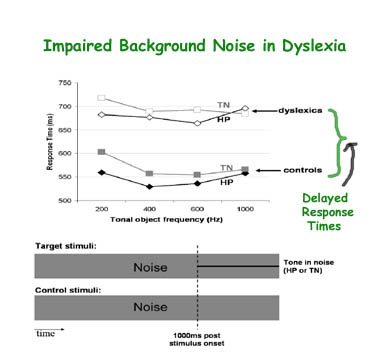It’s time when students are returning to the classroom and the child that struggles with reading and learning have a difficult time learning with background noise.
More data supporting the range of perceptual difficulties in dyslexia.
In the figure below, researchers found that dyslexic subjects showed delayed responses to sounds (HP stands for Huggins Pitch, TN stands for pure tone)when played with background noise. This background noise can be a big obstacle to efficient classroom learning for dyslexic students. Larger classes sizes, murmurings and rustlings from fellow classmates, and a fuzziness about phonology or weak auditory working memory, can spell failure (or ADD misdiagnosis) for even very smart or determined dyslexic students. This study only looked at tone and Huggins (kind of spectral noise) sounds…a test of similar-sounding phonemes might be even more dramatic.
This background noise can be a big obstacle to efficient classroom learning for dyslexic students. Larger classes sizes, murmurings and rustlings from fellow classmates, and a fuzziness about phonology or weak auditory working memory, can spell failure (or ADD misdiagnosis) for even very smart or determined dyslexic students. This study only looked at tone and Huggins (kind of spectral noise) sounds…a test of similar-sounding phonemes might be even more dramatic.
 This background noise can be a big obstacle to efficient classroom learning for dyslexic students. Larger classes sizes, murmurings and rustlings from fellow classmates, and a fuzziness about phonology or weak auditory working memory, can spell failure (or ADD misdiagnosis) for even very smart or determined dyslexic students. This study only looked at tone and Huggins (kind of spectral noise) sounds…a test of similar-sounding phonemes might be even more dramatic.
This background noise can be a big obstacle to efficient classroom learning for dyslexic students. Larger classes sizes, murmurings and rustlings from fellow classmates, and a fuzziness about phonology or weak auditory working memory, can spell failure (or ADD misdiagnosis) for even very smart or determined dyslexic students. This study only looked at tone and Huggins (kind of spectral noise) sounds…a test of similar-sounding phonemes might be even more dramatic.
Many parents and teachers out there might say, “Aha!”. Students with background noise problems often show wide variability in their classroom success, that may be due to teaching style, class size, degree of noise, or seat placement. Be vigilant to the possibility, and help your student advocate for classroom speakers if needed.
Now is this education or neurobiology? Both of course! We do a disservice to children if we can’t find efficient ways to share information between researchers, educators, and parents.
Orginally posted by Drs. Fernette and Brock Eide at 12:02 AM
